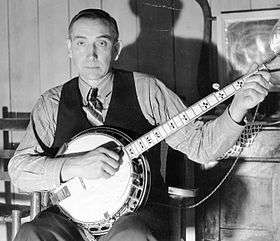Wade Ward
| Wade Ward | |
|---|---|
|
Wade Ward in 1937 | |
| Background information | |
| Birth name | Benjamin Wade Ward |
| Also known as | Uncle Wade |
| Born |
October 15, 1892 Independence, Virginia, U.S.A. |
| Died |
May 29, 1971 (aged 78) Independence, Virginia |
| Genres | Old-time |
| Occupation(s) | Farmer |
| Instruments | Banjo, fiddle |
| Years active | 1919 - late 1960s |
| Labels | Okeh, Folkways, Biograph, FRC |
| Associated acts | Buck Mountain Band, Bog Trotters Band |
| Notable instruments | |
| Gibson RB-11 banjo, now in the Smithsonian | |
Wade Ward (1892–1971) was an American old-time music banjo player and fiddler from Independence, Virginia.[1] He was especially renowned for his clawhammer banjo playing. He was a frequent winner at the Galax, Virginia Old Time Fiddler's Convention.[2] His instrument, a Gibson RB-11 5-string banjo, is now housed in the Smithsonian Institution. Along with Kyle Creed, Wade Ward is thought by many to embody the 'Galax' style of clawhammer banjo playing.
Biography
Ward began performing in public in 1919, at age 26. His first group, the Buck Mountain Band, included Van Edwards on fiddle and Van's son Earl on guitar.[3] In 1925, Ward recorded four solo tunes (unreleased) for the Okeh label during a field recording session in Asheville, North Carolina.[4] In October 1929 he and the Buck Mountain Band recorded four more tunes for Okeh in Richmond, Virginia, two of which were released.[5] In the early 1930s, Ward joined a band called the Ballard Creek Bogtrotters, formed by his older brother Crockett, who was twenty years his senior. Ward played banjo, Crockett and his neighbor Alec "Uncle Eck" Dunford played fiddles, Crockett's son Fields played guitar and sang, and the Wards' family doctor W. P. Davis managed the group and occasionally played autoharp.[6] Folklorist John A. Lomax discovered the group in 1937 at the Galax Fiddlers' Convention and recorded them for the Library of Congress. John's son Alan Lomax recorded Wade in 1939, 1941, and again in 1959; nearly 200 recordings of Ward are archived at the Library of Congress' American Folklife Center.[6] Other folklorists including Mike Seeger and Peter Hoover made additional field recordings in the 1950s and 1960s.[7] The Bogtrotters appeared at festivals during the folk revivals of the 40s and 50s.
Despite his musical gifts, Ward made his living as a farmer.[8] He died in 1971 in Independence, Virginia, and is buried in the Saddle Creek Primitive Baptist Church Cemetery a few miles west of town.[9]
Discography
| Year | Title | Label | Number | Notes |
| 1929 | "Don't Let the Blues Get You Down" / "Yodeling Blues" | Okeh | 45428 | 78 rpm |
| 1962 | Music of Roscoe Holcomb and Wade Ward | Smithsonian Folkways | F-2363 | |
| 1968 | Fields and Wade Ward: Country Music | Biograph | RC-6002 | |
| The Original Bog Trotters | Biograph | RC-6003 | ||
| 1972 | Uncle Wade - A Memorial To Wade Ward: Old Time Virginia Banjo Picker, 1892-1971 | Smithsonian Folkways | F-2380 | |
| 2004 | Uncle Charlie Higgins, Wade Ward & Dale Poe | Field Recorders' Collective | FRC-501 | recorded 1959 |
| 2007 | Wade Ward: Banjo & Fiddle | Field Recorders' Collective | FRC-507 | recorded 1959-1961 |
- Many other recordings by Wade Ward have been released on compilation albums from Smithsonian Folkways, Biograph, Rounder, County and other labels.
See also
- Alan Lomax
- Charlie Higgins
- Clawhammer
- High Atmosphere, 1975 Rounder Records compilation
- Old-time music
References
- ↑ Poole, Steve (November 10, 2003). "Poole & Mason Family". Rootsweb. Retrieved 2009-05-10.
- ↑ "Winners". Old Fiddler's Convention, Galax, Virginia. Retrieved 2009-05-10.
- ↑ Baycu, Ahmet. "Amazing Facts from the Roots of American Fiddle Music". HeaHeah. Retrieved 2009-05-10.
- ↑ Laird, Ross; Brian Rust (2004). Discography of OKeh Records, 1918-1934. Westport, CT: Praeger Publishers. pp. 141, 584. doi:10.1336/0313311420. ISBN 978-0-313-31142-0.
- ↑ Huber, Patrick (2008). Linthead Stomp: The Creation of Country Music in the Piedmont South. Chapel Hill: UNC Press. p. 297. ISBN 0-8078-3225-1.
- 1 2 Baycu, Ahmet. "The Bogtrotters". HeaHeah. Retrieved 2009-05-10.
- ↑ Hoffman, John. "The Peter Hoover Collection". The Field Recorders' Collective. Retrieved 2009-05-17.
- ↑ "Banjoist Wade Ward To Be Remembered". The Roanoke Star. 2013-10-08. Retrieved 2016-10-11.
- ↑ Weaver, Jeffrey (April 2008). "Saddle Creek Primitive Baptist Church Cemetery". New River Notes. Retrieved 2009-05-17.
Further reading
- Davidson, Eric; Rigg, Jane (2001). "Uncle Wade: A Memorial to Uncle Wade Ward, Old-Time Virginia Banjo Picker [1892-1971]". In Titon, Jeff Todd; Carlin, Bob. American Musical Traditions. Vol. 3, British Isles Music. New York: Schirmer Reference. pp. 94–100. ISBN 0-02-864624-X.
